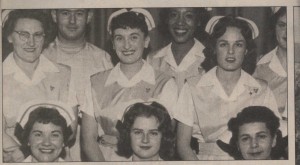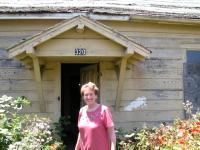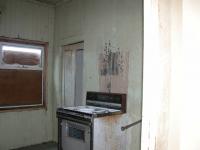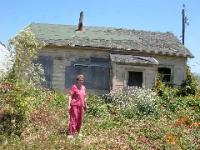By June Morrall
I wrote this shocking story in 2003.
During WWII, Half Moon Bay’s Main Street, and everything to the west, including the beaches, was off-limits to those folks without citizenship papers
It was a frightening time on the Coastside. If you were Italian in Half Moon Bay at the beginning of World War II–and didn’t have citizenship papers–there was a possibility of danger and humiliation.
At the time was broke out, Half Moon Bay was a close-knit farming community and Main Street was the hub of the small town’s commerce. The locals shopped at the same stores, ate the familiar restaurants, raised their glasses at the saloon, prayed at the beautiful Catholic Church and sent their kids to the grammar and high schools.
But all that changed after the Japanese bombed Pearl Harbor on December 7, 1941.
“I was in church that Sunday,” Josephine Giurlani Silva Revheim recalls, “and the next day the U.S. Army and Navy signal corps trucks were driving into Half Moon Bay. They took over the hotel and other buildings all the way up the coast towards Devil’s Slide.”
Today (2003) “Jo” Revheim is a retired nurse, a widow and longtime Pacifica resident. At the start of the war, she was the 15-year-old daughter and only child of farmer Antonio Giurlani and his wife Marianna.
The Giurlanis grew sprouts and chokes on land adjacent to the old Catholic church that once stood west of Main Street. In between masses, Jo helped tidy the church, and she recalls ironing shirts for the much-loved Father.
The Giurlanis had come from Lucca, Italy, but Jo’s mother was actually born in Marseilles, France. Still, everyone in Half Moon Bay considered her Italian.
Soon after the army trucks rolled into Half Moon Bay, Josephine remembers, her father received an offical letter from the U.S. government ordering the family to move to the east side of Main Street.
They were also required to register in San Mateo.
Why did the officials select Main Street as the place to draw the line, separating east from west? Main Street was the Highway 1 of its time, and everything to the east, including the beaches, was off-limits to those folks without citizenship papers.
Josephine recalls that the grocery store, the bakery and everything else was on the west side. The east side was where people lived, and unless you had a relative to help, there was no place to move to.
Printed notices ordering all “aliens, German, Italian and Japanese” to re-locate were plastered on telephone poles in the town. The Japanese were rounded up and detained at Tanforan racetrack in San Bruno. Their history is well documented. But in Half Moon Bay, Josephine notes, there was no central location for the Germans and Italians. After registering in San Mateo, they simply had to leave their homes on the west side.
The while line painted down the center of Main Street not only separated east from west, it made some lcoals suspicious and fearful of those who did not have citizenship papers and had been pushed away. A person who had been your friend a week earlier might turn sullen and threatening.
“We were never to cross that white line!” Josephine exclaimed today (2003).
Crossing meant that they would surely be reported and possibly dragged before the local judge, or worse. Fortunately, not everybody was mean.
For example, Judge Manuel Bettencourt, was kind and showed compassion when dealing with non-citizens.
But there were exemptions to the order, and Jo says since she was younger than 16, she was not required to move. Neither was her mother, being French. The order was clearly aimed at Jo’s father, an Italian with no papers and little education.
Technically, Josephine and her mother could have stayed on the farm but she asks: “How could we maintain a large farm without dad’s help?”
The decision was not difficult. Whatever the hardships, this family would stick it out together.
How many families faced similar circumstances? Jo estimates some five to ten Half Moon Bay families were in the same boat.
In instances, where some family members had papers, and some didn’t, they had to decided whether to break-up or cross the white line together.
There’s the story of one family that operated a business on Main Street. The parents, without papers, had to shout instructions to their citizen children across the street.
How could this happen? How could a white line tear apart the social fabric of a small farming community?
The attack on Pearl Harbor had created an atmosphere of near panic. It’s no surprise that people on both sides of the white line were faced with impossible decisions.
Would the Japanese invade California?
Military experts had long recognized the logistical importance of the Coastside. In the late 19th century they warned that Half Moon Bay could prove to be a “back door” for a foreign, hostile fleet. The enemy could land at Pillar Point and march, without resistance, conquering all of San Mateo and San Francisco.
After Pearl Harbor, desperate measures were taken to protect the Coastside, to close that vulnerable door. The military patrolled the beaches, bunkers were built–some of those WWII relics can be seen today from Highway 1 near Devils Slide–and gun emplacements dotted the hills overlooking the Pacific.
Local citizens volunteered to scour the beaches looking for submarines and scn the skies for enemy aircraft.
Meanwhile, Josephine’s family dealt with their own emergency, scrambling to find a roof to put over their heads. The government had given all the aliens a two-week deadline to relocate. The Giurlanis had to harvest their crops and move everything they had, including the goats, chickens, rabbits and horses. Incidentally, they were prohibited from taking radios and guns.
As the two-week deadline crept closer, it was like a noose tightening around theirs.
Then a fortuitous turn of events.
“Luckily,” Josephine says, “Dad had a farm friend, Mr. Cassinelli, who owned a large ranch in Higgins Canyon, south of town. He not only hired dad, he gave our family a place to live in the Johnston House. In those days it wasn’t called the Johnston House–we called it ‘the old house on the hill’.”
The old house was vacant, and the local kids were convinced it was haunted.
“Finally, at midnight, the deadline time for the great move,” Josephine says, “we loaded up all our belongings and animals and made our way through town and landed in the Johnston House.
“the next morning,” she continues, “it hit us, what we were in for. The rat-infested house had no windows, and vagrants had slept there, leaving behind garbage. Straw covered the dirt floors, the outhouse was halfway up the hill in the back, and when it rained, it was like a waterfall, but there was plenty of room, and thank God there was cold running water to drink.”
Most important, the house was located on the “East” side.
But the worst part for Josephine, the teenager, was not knowing: “When could we go back to our home, if ever?”
Sitting in her charming two-story home in Pacifica today (2003), Josephine Revheim reflects on those tumultuous days. “We had no way to purchase food for our families, unless we disobeyed the law and crossed the street to buy it, and guess where all the stores were?”
They were on the wrong side of the street for the Giurlanis.
The school was also on the west side, and she couldn’t go there.
The most humiliating part of the whole experience for this teenager were the stares and unfriendliness she and her family encountered.
There were times when the Giurlanis were able to circumvent the restrictions. On one occasion Josephine and her mother harvested the artichokes at their farm on the west side while her father, prohibited from going himself, waited in the car on the east side. They got the chokes back to the Cassinelli ranch where they were crated and sent to market in San Francisco.
Some of her remembrances are so unpleasant that Josephine is uncomfortable even thinking about them today. She quirms when recalling that one malicious neighbor actually reported her mother’s visits to the farm on the west side.
Even though she was French she had to appear before Judge Bettencourt to prove she wasn’t subject to restrictions, and the good judge reassured her of her exempt status.
The worst recollection of all was of her mother successfully fighting off an assault by some angry, unthinking local.
“For the Italian families, the nightmare ended after about five months. Josephine reminds us that “the Japanese had it so much harder and suffered so much and lost everything.”
As to those German non-citizens on the Coastside, Jo had no information.
“We came home,” she says, “and at least the house and barn were still there. Everything else was gone, the crops were gone, and even our wild pigeons that had nested in the barn were gone.”
The Giurlanis were back in the house and it wasn’t long before they received a letter from the U.S. government advising them to become citizens or face deportation. They all got their citizenship papers.
For a time, the family continued to farm the land beside the old Catholic Church. Later, they moved to Pacifica, where Jo’s father worked in construction for the developers Doelger and Oddstad.
Josephine married, became the mother of three children and attended the College of San Mateo, earning her degree as a licensed vocational nurse in 1963. She spent 15 productive years working on the eighth floor at Peninsula Hospital in Burlingame.
 (Jo Giurlani Silva Revheim (center) with fellow College of San Mateo nursing graduates in 1963.)
(Jo Giurlani Silva Revheim (center) with fellow College of San Mateo nursing graduates in 1963.)
When Jo’s parents fell ill, she tended them with great love until the end of their lives.
Jo Revheim still has friends in Half Moon Bay and visits regularly.
One source of constant amazement to Jo is how magnificent the Johnson House appears today, compared to the hovel she lived in with her parents more than half a century ago. She takes particular pride in the help she provided to the Johnson House Foundation when they asked her for sketches of how the house looked in the 1940s.
——————
——————
Shortly after my interview with Josephine Revheim, we took a ride to Half Moon Bay to see the house she had lived in as a 15-year-old before her family was ordered to move out of it. Surprisingly the house was still standing, but it was vacant and uncared for, with broken glass on the floor, grafiti on the walls, empty paper coffee cups, somebody’s crash-pad, and, right there, in the middle of town.
Here are some photos from that day; arriving at the house, looking at the washing machine inside. Josephine is the lady in pink.




